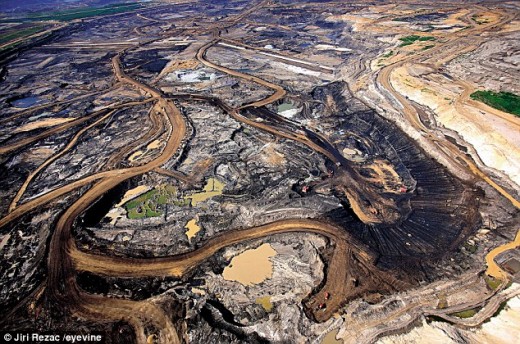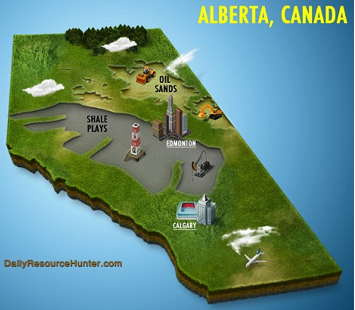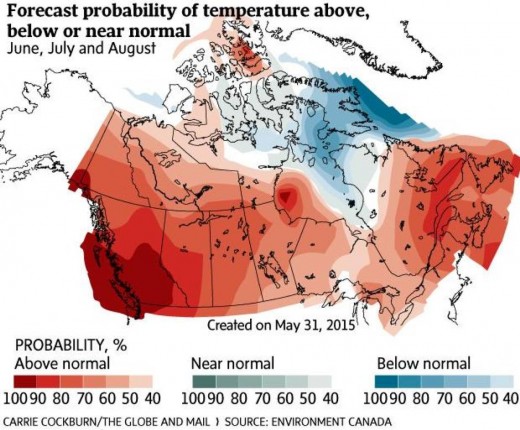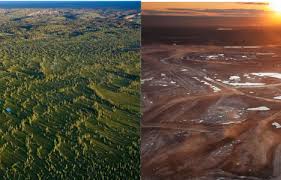Canada's Mordor: European Report Slams Alberta's 'Dirty Oil'
Mordor? Or the Alberta Tar Sands?

What is happening in Canada?
A recently released report condemns the European Union's imports of Alberta's 'dirty' tar sands oil and labels Canada a 'climate criminal'. The world's leading scientific periodical called, 'Nature', also published that 85% of the Alberta Tar Sands needs to remain 'in the ground' to stop any further rise in temperatures. Alberta and Canada are feeling the pressure within Canada itself and from its global neighbors. To give you an idea, the whole Tar Sands area, most of which has not been mined yet covers an area the size of England.
The report is officially entitled, "Tarsands: Europe's Complicity in Canada's Climate Crimes" was released by our own Council of Canadians in collaboration with Friends of the Earth Europe and is enclosed at the end of this article for your review. The report states that the Alberta Tar Sands and an expanse across the northern wilderness is Canada's main source of oil pollution and emissions and is the reason it will not live up to climate change goals. Environmentalists agree the development of the Alberta Tar Sands shows how desperate the world is for oil. The Tar Sands are called that because it is a mix of petroleum, clay, sand and water. Extracting oil from it is very challenging and it takes a tremendous amount of water, capital, labor and energy to extract and process. Next to ocean drilling, it is one of the most expensive methods.
Mining the Tar Sands involves water injections and surface mining. Water injections steam the oil out of the ground to the surface for removal. Surface mining involves the clearing of entire forests and top layers of soil. This leaves the land a barren wasteland and the landscape totally devoid of any vegetation.This is why critics call it, 'The Canadian Mordor'.
In-situ water extraction is more common than open pit mining in Alberta. Roughly 97% of tar sands deposits are too deep below ground for open-pit mining. In-situ water extraction is the most intensive process and uses high amounts of natural gas and 3 barrels of water for every barrel of oil extracted. Well pads covering an area larger than a soccer field are constructed to blast high temperature steam underground in order to melt tar sands deposits at depths of up to 500 meters (as hard as a hockey puck at this depth). Once liquefied, the tar sands crude is pumped to the surface. Forests are cut and dissected to make way for well pads and a supporting network of pipelines, service roads and power lines.
The land is supposed to be reclaimed after extraction but only 0.15% of Tar Sands land has gone through some sort of recovery process but no one knows what that is. Industry is supposed to return the land to its natural state and 'reclaim' the land but returning to it's natural state is virtually impossible. A mature forest takes centuries to develop, it can't be returned to its natural state overnight. It takes decades for a forest to grow back.
An entire ecosystem is being disrupted in Alberta and this is what regulates temperatures in the area. Forest loss or deforestation adds up to 23% of total man made emissions. The other losses are from changing land uses that removes forests such as clearing for agriculture, building, cities or industry. The fact is forests are being removed at an alarming rate especially in Alberta. Even the removal of a forest releases CO2 in the process, add to it the pollution that follows from production.
As we are taught in grade school, a forest absorbs dangerous CO2 and creates oxygen. Using energy from the sun, they turn the carbon captured from the CO2 molecules into building blocks for their trunks, branches and foliage. This is all part of the carbon cycle. Forests are also called 'carbon sinks' that absorb over a quarter of human caused emissions. In a warming area, what is needed is 'more' forests not less to combat pollution. Forests affect weather too by warming areas in the winter and also absorbing and reflecting heat in the summer. The water issue is a major issue, too.
In 2011 alone, tar sands operations consumed 170 million cubic metres of water, equivalent to the annual usage of Barcelona. Most of this water is too toxic to be returned to rivers and aquifers and is permanently removed from the water cycle.The tons of toxic sludge is now being stored in huge dams called Tailing Ponds that are actually visible from space. Eleven million litres of toxic water seeps from tar sands dams (comprising an area 176 kilometres sq.) everyday. This has lead to increased cancer cases in places like Fort Chipewan that now have lawsuits against companies. Studies from the University of Manitoba found high levels of toxic metals in wildlife foods such as moose. Mutant fish were also found in Lake Athabasca where tailpond water is leaking into the watersheds and the surrounding ecosystem. (See report).
The National Energy Board Act, the Fisheries Act and the Species at Risk Act are other examples of environmental regulations that have been removed from Canadian Law that were there to protect people, land and water. In 2012, the National Round Table on the Economy and the Environment was closed down and the Canadian Foundation for Climate and Atmospheric Science funding were discontinued removing protections for Canadians. Many protective laws, policies and funding for science and environmental programs were chopped during the reign of the Harper Conservative Government. Most likely in support of plausible deniability- out of sight, out of mind...of the public eye.
Between the Tar Sands and the potential risk of proposed Shale Mining covers almost half of the province. Proposed Shale plays span a larger expanse than the Tar Sands. Oil wells also cover much of central and northern Alberta. Few are making the connection between the ongoing drought in Alberta with its high pollution rates and deforestation. Temperatures in the province have been steadily increasing causing climate changes directly in the region. The connection between severe drought, higher temperatures and areas of oil production on the map are the same areas.

Temperatures 90% Above Normal in Alberta

Alberta Oil Sands-before and after

Is help on the way?
The Friends of Earth Europe report criticizes Canada's climate change record and points out the country is way off track now exceeding 1990 emission levels by 18% and has only committed to reducing emissions by 14% below 1990 levels by 2025. This falls way short of global expectations compared to the European Union which submitted commitments to reduce emissions by 40% before 2030. Even the European Union isn't meeting global goals. Although noble goals, none of it is enough to reduce emissions to the zero emissions goal by 2030. Fast action and change is required not soon, but now. Climate change waits for no one.
The truth is all major developed countries have been slacking for a very long time and emission levels are increasing. Plans for more pipelines and mining shows Alberta big oil players have not accepted its fate and the Federal Government is slow to enforce national commitments or global goals. Albertans are literally caught between a rock and a hard place. Reports prove the world is watching.
On behalf of Albertans...
Albertans hear and read less about these local impacts than the rest of the world. There is a certain degree of censorship on these matters which implies one cannot bite the hand that feeds you. Alberta's economy is driven by the oil industry and their livelihoods very much depend on it. They are in a precarious position...caught between industry, government and the world.
It is fact they are suffering from great job and income losses and the retroactive benefits to the side industries.Even local retailers and restaurants are emptier while construction projects and real estate are on hold. Over 100,000 jobs have been lost this year. Here everyone is hurting where savings are dwindling and unemployment insurances are running out. Social welfare is the last resort and is barely enough to cover a mortgage payment. People are losing their homes, vehicles and worried they cannot feed their families.The only busiest sector is the food banks, missions and charities. This author knows...she is fundraising harder than ever.
Albertans care about the environment but also do not want to be destitute and on the streets. If alternative energy jobs were available, most would switch over in a heartbeat even if simply to have a decent income once again. Everyone here is looking for that big investment in alternative energies that can save this situation, but it hasn't come yet. They need a choice. If the world is our biggest critic, perhaps the world should start investing in Alberta's economy as well... besides oil and gas. How can Albertans put their money where their mouths are...they do not have any. It all resides with big oil business, investors and government. Help 'them' make a better choice. Money talks.
Someone should really call up IREA, the International Renewable Energy Agency and ask them not to forget about investing in renewables in Alberta. It would help...a lot.
The report entitled, 'Tar Sands: Europe's Complicity in Canada's Climate Crimes', was a partnership between the social justice organizations Friends of the Earth Europe and the Council of Canadians. Friends of the Earth Europe is the European arm of Friends of the Earth International which unites 74 national member organizations and over 5,000 local activist groups, and over two million supporters around the world. The Council of Canadians is Canada's leading social action network of 64 member chapters across the country.
Note: A courtesy copy of this article has been supplied to the Friend's of the Earth Europe, Friends of the Earth International, the Council of Canadians and the International Renewable Energy Agency (IREA).
Sources:
Tarsands: Europe's Complicity in Canada's Climate Crimes. 2015 http://canadians.org/sites/default/files/publications/report-tar-sands-1115.pdf
How do Trees and Forests relate to Climate Change. The Guardian, Feb. 2011. http://www.theguardian.com/environment/2011/feb/11/forests-trees-climate
Canada's Shale Boom: Unlocking Alberta's Oil & Gas. Daily Reckoning, 2013. http://dailyreckoning.com/canadas-shale-boom-unlocking-albertas-oil-gas/








